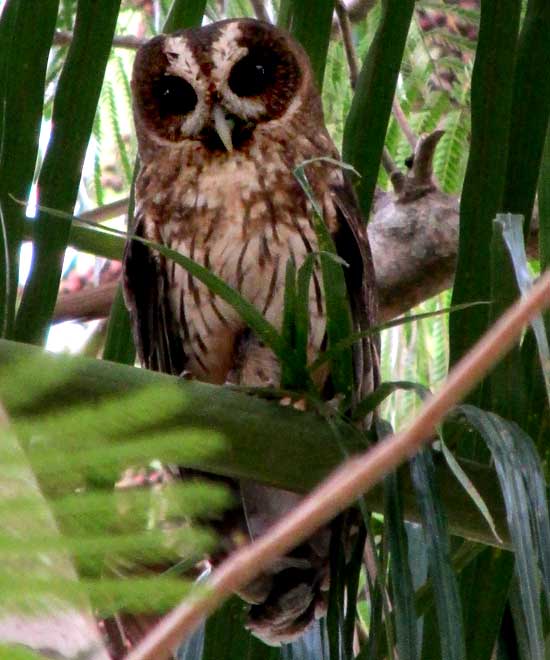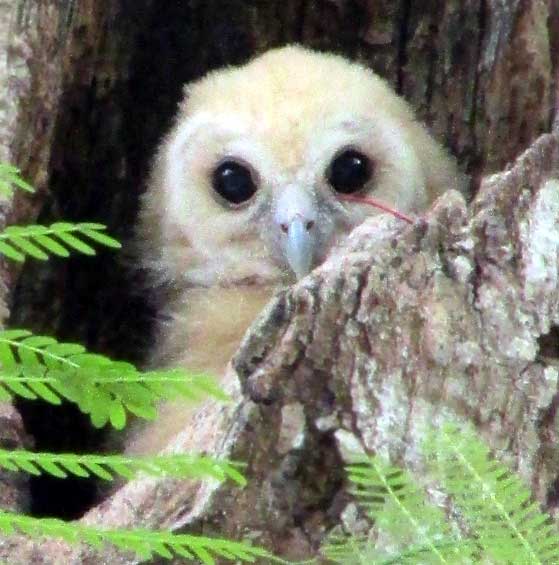Excerpts from Jim Conrad's
Naturalist Newsletter
from the June 5, 2016 Newsletter issued from Hacienda Chichen Resort beside Chichén Itzá Ruins; limestone bedrock; elevation ~39m (~128ft), N20.675°, W88.569°; central Yucatán state, MÉXICO
MOTTLED OWL NEST WITH YOUNG
Late Wednesday afternoon Luis from the Hacienda's restaurant came to tell me that a mama owl with her white baby could be seen next to the Hacienda reception area. When I got there it was hard to believe that an owl had nested where so many people, including myself, pass by several times a day. It was just a few feet from both the parking lot entrance and where big tour buses with their diesel engines rumbling deposit arriving guests. At first I didn't see the owls but finally Luis pointed out what I assumed to be the mother, perched in deep shadows among palm fronds, as shown below:

It was easy to figure out that this was a Mottled Owl, STRIX VIRGATA. Here in north-central Yucatan we have only larger Barn Owls with their white facial disks, Great Horned Owls that also are larger and with "ear tufts," the much smaller Ferruginous Pygmy Owl, and the Mottled Owl. Throughout most of tropical, lowland Mexico, south through Central America to Ecuador and northern Argentina, Mottled Owls are fairly common in a variety of habitats -- upland pine-oak forest to lowland plantations and thorn forest. However, normally they're secretive, and much more commonly heard than seen.
Mottled Owls come in dark and light morphs, the light morphs being most common in arid areas, so that's the morph I've seen in arid northern Mexico. This one was a dark morph, the one commonly seen in southeastern Mexico and Central America.
And then Luis pointed to the nestling who'd been watching us all along from his hollow in an old Royal Poinciana tree, just a few feet in front of and below the adult, shown below:

The owlet is seen up closer below:

At night I hear Mottled Owl hoots very close to the hut. I'm getting the impression that they like being near habitations. Once in Guatemala's Quetzal Reserve I found the Quetzals not on wooded slopes of their Reserve, but lined up along the main road at the Reserve's border, apparently fascinated by the continual line of diesel trucks with their ear-splitting exhaust noise and great plumes of oily smoke as they crossed the mountain's ridge.
The owl's hoots aren't as loud or well enunciated as those of the larger owls. The calls vary, but lately right before sunrise the main call has been three or so low, monotonal, slightly wheezy woop calls, a little like the Hollywood version of a big sword repeatedly sliced through the air, woop... woop... woop...
from the June 12, 2016 Newsletter issued from Hacienda Chichen Resort beside Chichén Itzá Ruins; limestone bedrock; elevation ~39m (~128ft), N20.675°, W88.569°; central Yucatán state, MÉXICO
MOTTLED OWL IMMATURE UPDATE
Last Monday for the first time both parents of the fuzzy-white Mottled Owl juvenile reported on last week appeared nearby the young one, the couple shown below:

This Tuesday morning they were still there, and the little one was entertaining the work crew by perching on a lower branch of the big Mango tree above the sidewalk next to the laundry room, watching us below with big, black eyes.
That night we received the first puddle-forming rain of the rainy season, about half an inch (13mm), and Wednesday morning the whole family had disappeared. However, late Friday the immature was spotted high in a tree several trees from his last known location. Unless during the night he went to the ground, it's hard to see how he got to that tree, since his wing feathers don't look anywhere near developed enough to fly. I suppose the parents are nearby, but they're hard to see, since they're so well camouflaged, stick to the shadows, and don't move.
from the March 31, 2008 Newsletter written in the community of 28 de Junio, in the Central Valley, 8 kms east of Pujiltic, Chiapas, MÉXICO
MOTTLED OWL SNARLING
The most common owl here, abundant and calling throughout much of the night and day with monotonous and easily imitated whistled beeps, is the Ferruginous Pygmy-Owl. The next-common owl, heard most nights but rarely seen, is the Mottled Owl, STRIX VIRGATA.
The first night I slept in the reserve one swooped over our little medicinal plant garden and landed in an acacia right above me, its black silhouette clearly visible against the night sky through my tent's transparent top-webbing. I identified it mostly through the process of elimination. It was too large to be one of the screech-owls, but wasn't large enough to be a horned owl, plus it lacked "horns" or ear-tufts.
And then my visitor hooted. There were five deep, resonant hoots like the North's Barred Owl's, with whom it's closely related, but then came a truly toe-curling call described by Howell as a wailing scream but which to me sounded like the kind of snarl a wild, prowling feline might make.
The next day, referring to Howell's distribution maps and taking into consideration the owl's size, earless silhouette, habitat, and its unforgettable snarl, I decided it was a Mottled Owl. The species is described as common in a wide variety of tropical habitats from Mexico to northern Argentina.
My guess is that the snarl evolved back when big cats roamed the land. If an owl could make itself sound like a prowling cat, sometimes it might unnerve a critter who'd bolt from his hiding place, enabling the owl to swoop and catch it. It's similar to our northern Bluejays who occasionally emit snarls imitating circling hawks. Maybe you've seen that call clear a bird-feeding area of all birds, enabling the Bluejays to swoop down and have the place all to themselves.